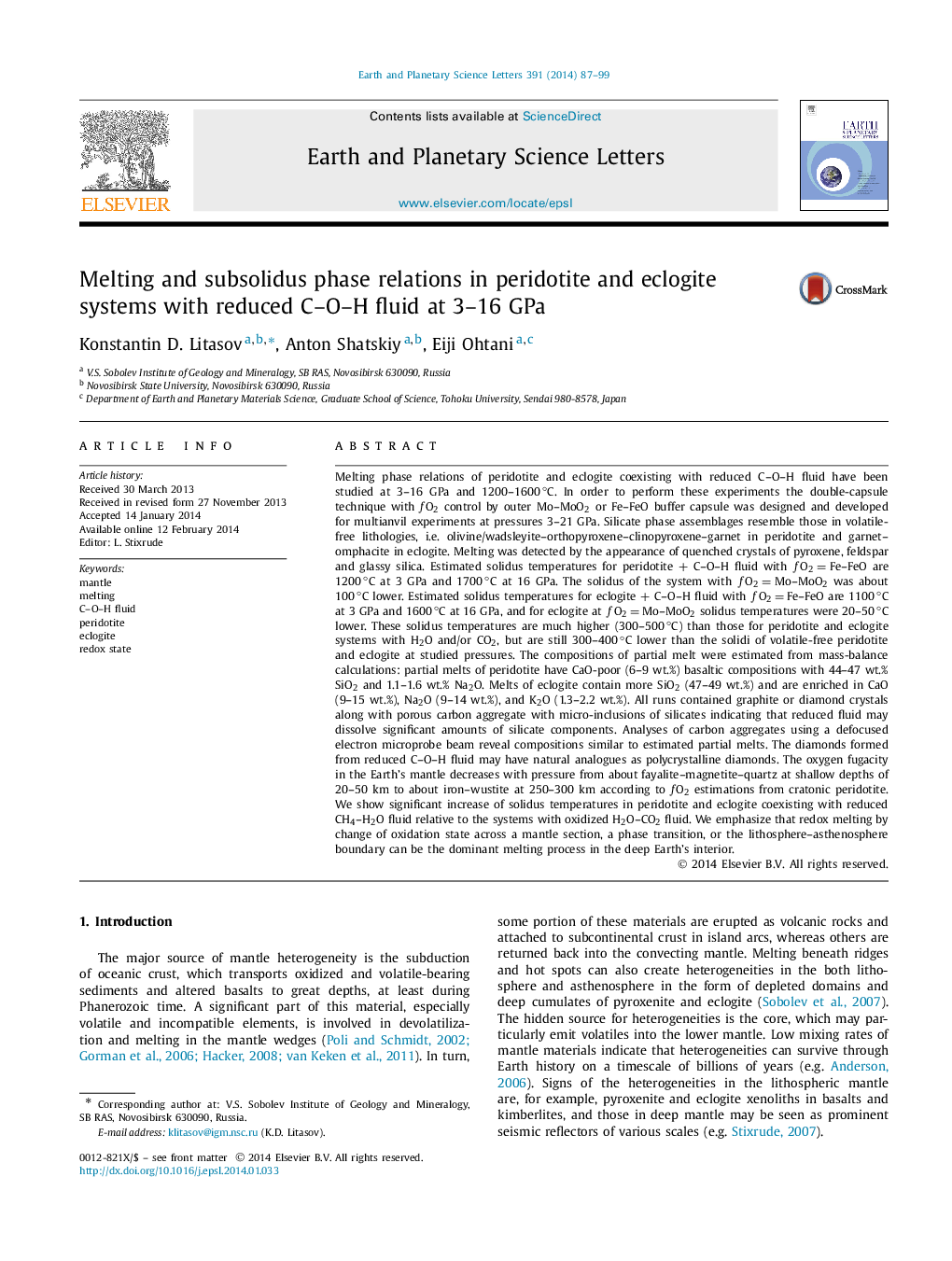| کد مقاله | کد نشریه | سال انتشار | مقاله انگلیسی | نسخه تمام متن |
|---|---|---|---|---|
| 6429431 | 1634765 | 2014 | 13 صفحه PDF | دانلود رایگان |

- Peridotite and eclogite coexisting with reduced C-O-H fluid studied at 3-16 GPa and 1200-1600â°C.
- The double-capsule technique with fO2 control by Mo-MoO2 and Fe-FeO buffer was used.
- The solidus temperatures were higher (300-500â°C) than in the systems with H2O and CO2.
- The partial melt from peridotite and eclogite has basaltic composition.
- We argue that redox melting can be important melting process in the deep Earth's interior.
Melting phase relations of peridotite and eclogite coexisting with reduced C-O-H fluid have been studied at 3-16 GPa and 1200-1600â°C. In order to perform these experiments the double-capsule technique with fO2 control by outer Mo-MoO2 or Fe-FeO buffer capsule was designed and developed for multianvil experiments at pressures 3-21 GPa. Silicate phase assemblages resemble those in volatile-free lithologies, i.e. olivine/wadsleyite-orthopyroxene-clinopyroxene-garnet in peridotite and garnet-omphacite in eclogite. Melting was detected by the appearance of quenched crystals of pyroxene, feldspar and glassy silica. Estimated solidus temperatures for peridotite + C-O-H fluid with fO2=Fe-FeO are 1200â°C at 3 GPa and 1700â°C at 16 GPa. The solidus of the system with fO2=Mo-MoO2 was about 100â°C lower. Estimated solidus temperatures for eclogite + C-O-H fluid with fO2=Fe-FeO are 1100â°C at 3 GPa and 1600â°C at 16 GPa, and for eclogite at fO2=Mo-MoO2 solidus temperatures were 20-50â°C lower. These solidus temperatures are much higher (300-500â°C) than those for peridotite and eclogite systems with H2O and/or CO2, but are still 300-400â°C lower than the solidi of volatile-free peridotite and eclogite at studied pressures. The compositions of partial melt were estimated from mass-balance calculations: partial melts of peridotite have CaO-poor (6-9 wt.%) basaltic compositions with 44-47 wt.% SiO2 and 1.1-1.6 wt.% Na2O. Melts of eclogite contain more SiO2 (47-49 wt.%) and are enriched in CaO (9-15 wt.%), Na2O (9-14 wt.%), and K2O (1.3-2.2 wt.%). All runs contained graphite or diamond crystals along with porous carbon aggregate with micro-inclusions of silicates indicating that reduced fluid may dissolve significant amounts of silicate components. Analyses of carbon aggregates using a defocused electron microprobe beam reveal compositions similar to estimated partial melts. The diamonds formed from reduced C-O-H fluid may have natural analogues as polycrystalline diamonds. The oxygen fugacity in the Earth's mantle decreases with pressure from about fayalite-magnetite-quartz at shallow depths of 20-50 km to about iron-wustite at 250-300 km according to fO2 estimations from cratonic peridotite. We show significant increase of solidus temperatures in peridotite and eclogite coexisting with reduced CH4-H2O fluid relative to the systems with oxidized H2O-CO2 fluid. We emphasize that redox melting by change of oxidation state across a mantle section, a phase transition, or the lithosphere-asthenosphere boundary can be the dominant melting process in the deep Earth's interior.
135
Journal: Earth and Planetary Science Letters - Volume 391, 1 April 2014, Pages 87-99